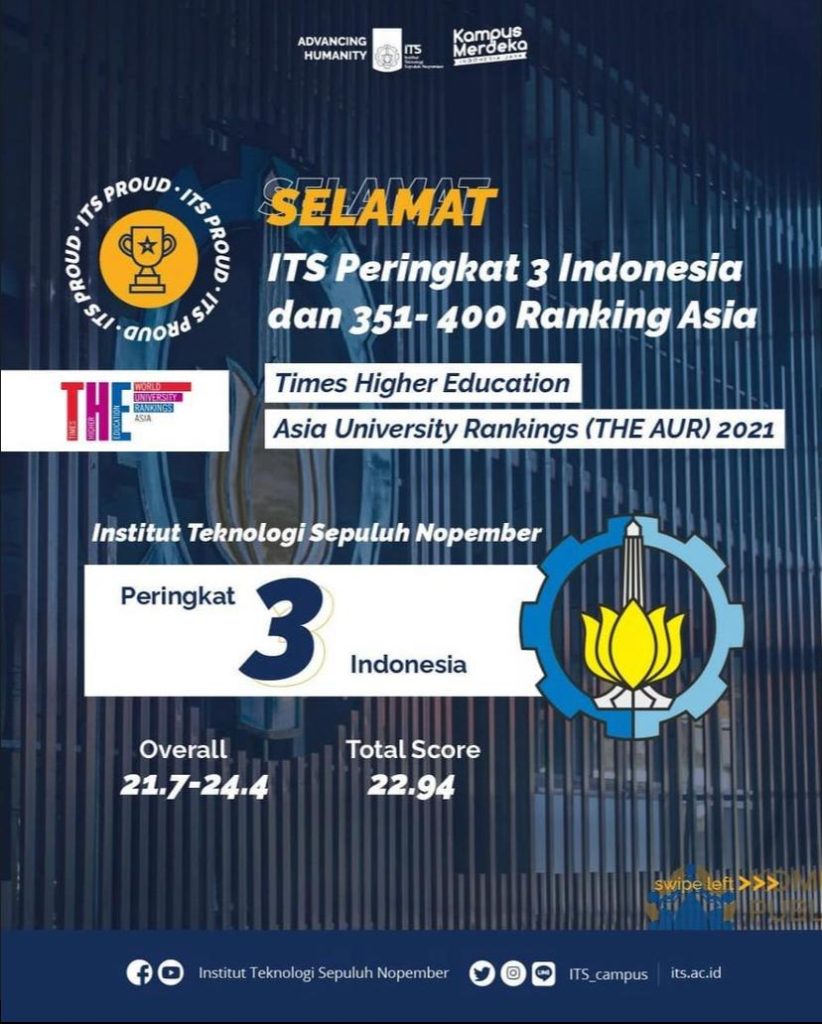ITS Ranks Three of the Best Universities in Indonesia

ITS scoring results at THE AUR 2021 compared to other universities in Indonesia
ITS Campus, ITS News – The Institut Teknologi Sepuluh November (ITS) effort to bring the campus into a world-class university is no joke. The Covid-19 pandemic, which has been around for more than a year, has not prevented ITS from continuing to develop rapidly, as evidenced by the achievement of third place as the best university in Indonesia according to the Times Higher Education (THE) version.
Itself is a credible institution that presents data on university performance in the international arena in collaboration with Quacquarelli Symonds (QS). According to The Globe and Mail, THE is one of the most influential Asia University Rankings (AUR), which is held annually or commonly known as THE AUR.
Based on this year’s ranking, ITS’s excellence and qualifications are shown by occupying the third-best position in Indonesia with an average acquisition of 21.7 – 24.4. However, it was not enough to get there, and ITS also managed to reach the best 351 – 400 position in Asia in THE AUR 2021 with an average score of 22.94.

Rulli Pratiwi Setiawan ST MSc Ph.D., Senior Manager of ITS Global Engagement Office on World Class University Affairs
Senior Manager of ITS Global Engagement Office on World Class University Affairs Rulli Pratiwi Setiawan ST MSc Ph.D. conveyed the five criteria assessed in the THE AUR ranking. “There are criteria for teaching, research, citations, international outlook, and industry income,” she explained.
Furthermore, the alumnus of Universität Stuttgart Germany gave information about the weight of each criterion which was measured by percentage. The percentage of teaching criteria is 25 percent, research is 30 percent, citations are 30 percent, an international outlook is 7.5 percent, and industry income is 7.5 percent.
Rulli explained several requirements that universities must meet to follow or participate in THE AUR rankings. “The requirement is that lecturers must teach at least one student, then the university must have no more than 80 percent of staff for one area of study, and have published 1,000 journals in the last five years or at least 150 per year,” she explained.

The position of ITS which is ranked in the top three universities in Indonesia according to THE AUR 2021
Rulli said that ranking in THE qualification was an arduous struggle, coupled with tough competitors from other colleges. “This is the third year that ITS has entered the THE ranking and is slightly different from the QS ranking; the THE ranking is more difficult when viewed from the existing criteria,” added Rulli.
Not only that, but the 42-year-old woman also shared her views on the indicators in THE AUR 2021. The citations indicator is the indicator that experienced the most significant decline. “There is still a lot of homework (homework, ed) that must be addressed through various breakthroughs, especially in terms of research and publications to be able to increase citation achievements,” said the lecturer of the ITS Regional and City Planning Department (PWK).

ITS position in THE Asia University Rankings 2021, which is in position 351-400
In the future, Rulli hopes that ITS can continue to improve its reputation in the international arena. The ranking is not the ultimate goal, but at least it can be a benchmark to see the position of ITS at the world level. “Of course, then synergy and collaboration of the entire academic community are needed to be able to further strengthen ITS’s position at the world level,” concluded Rulli at the end of the interview.
The rankings in THE AUR 2021 itself were released through Ranking THE Asia University Rankings through “Virtual THE Live Asia” on June 3, 2021. Official information on the existing rankings can be accessed through THE official website or via the link timeshighereducation.com/world- university-rankings/2021/regional-ranking. (ITS Public Relation)
Reporter: Yanwa Evia Java
Related News
-
ITS Wins 2024 Project Implementation Award for Commitment to Gender Implementation
ITS Campus, ITS News —Not only technology-oriented, Institut Teknologi Sepuluh Nopember (ITS) also show its commitment to support gender
June 07, 2021 14:06 -
ITS Professor Researched the Role of Human Integration in Sustainable Architecture
ITS Campus, ITS News –The developing era has an impact on many aspects of life, including in the field
June 07, 2021 14:06 -
ITS Sends Off Group for Joint Homecoming to 64 Destination Areas
ITS Campus, ITS News — Approaching Eid al-Fitr, the Sepuluh Nopember Institute of Technology (ITS) is once again facilitating academics who want
June 07, 2021 14:06 -
ITS Expert: IHSG Decline Has Significant Impact on Indonesian Economy
ITS Campus, ITS News — The decline in the Composite Stock Price Index (IHSG) by five percent on March 18,
June 07, 2021 14:06
